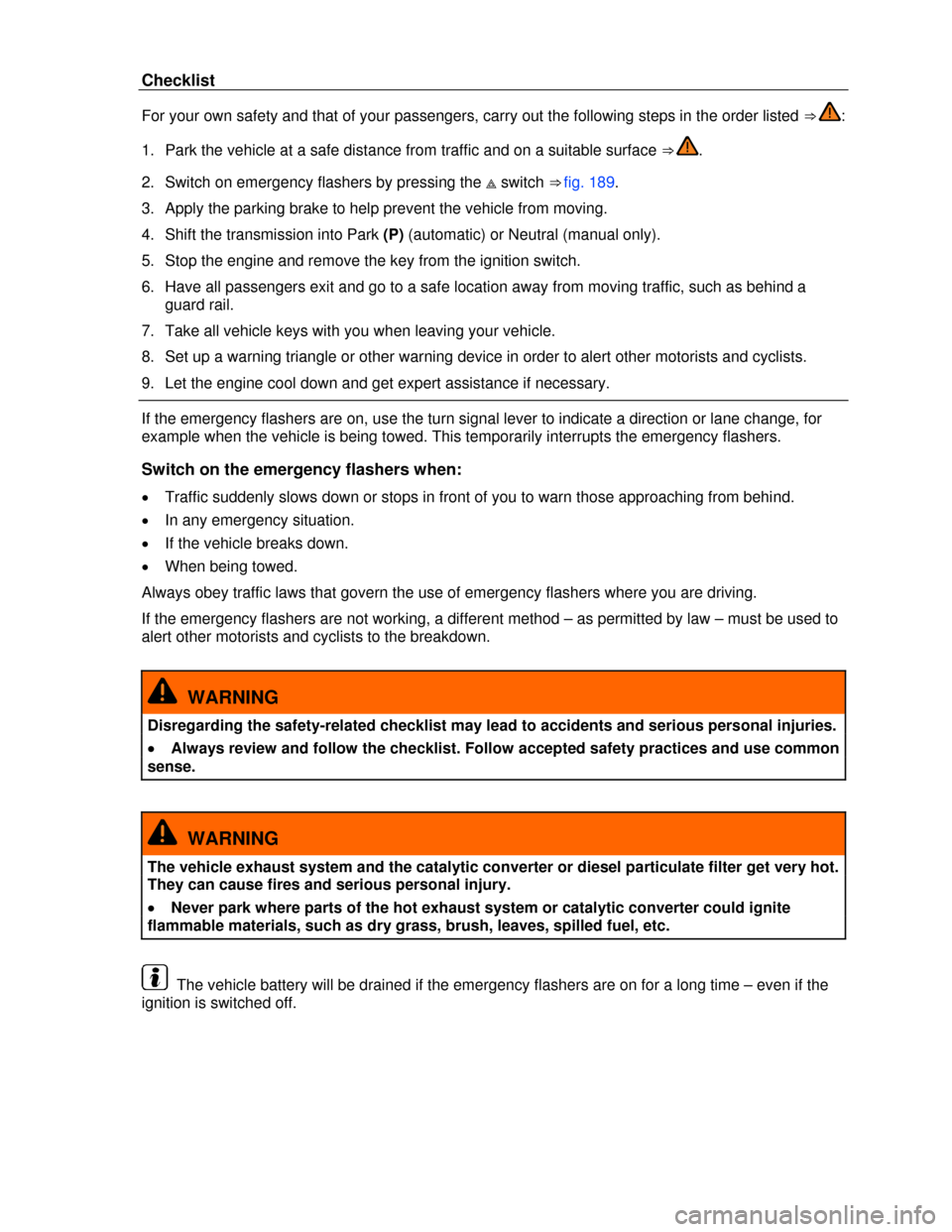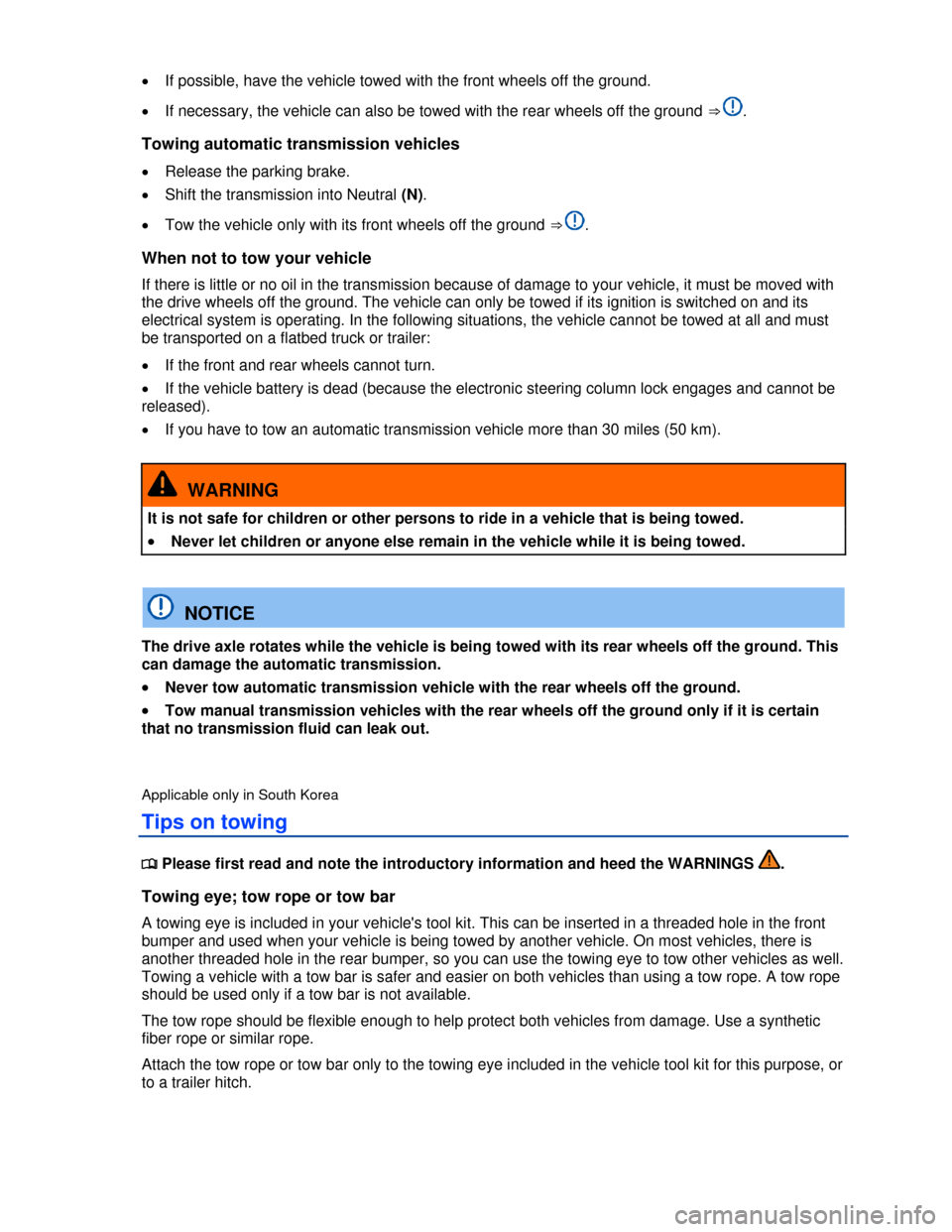Page 345 of 379

Description Possible causes among
others Possible remedy
Vehicle has run-flat or mobility
tires.
equipment. Contact an authorized
Volkswagen dealer or an authorized
Volkswagen Service Facility for
assistance.
Features do not work as
described in this manual.
Settings were adjusted in the
Volkswagen Information
System.
Check and reset to factory settings if
necessary.
Headlights do not light up
the road as they should.
– Headlights adjusted too high.
– Light bulbs burned out.
– Low beams not switched on.
– Have the headlight range adjusted by
an authorized Volkswagen dealer or an
authorized Volkswagen Service
Facility.
– Change light bulbs.
– Switch on low beams.
Electrical consumers do
not work.
Vehicle battery charge too low. Charge vehicle battery.
Remaining fuel level too low. Refuel.
Fuse blown. Check fuse and replace if necessary.
Fuel consumption higher
than indicated.
– Short hauls.
– “Jumpy” accelerator pedal.
– Avoid short distance driving.
– Drive defensively.
– Accelerate smoothly.
Electrical loads switched on. Switch off unnecessary loads.
Engine control malfunctioning. Have the malfunction corrected.
Tire pressure too low. Adjust tire pressure.
Driving in the mountains. No direct corrective action possible.
Towing a trailer. – Check use.
– Remove if not in use.
Driving with heavy payload. No direct corrective action possible.
Driving at high engine speed. Select a higher gear.
Page 347 of 379

Checklist
For your own safety and that of your passengers, carry out the following steps in the order listed ⇒ :
1. Park the vehicle at a safe distance from traffic and on a suitable surface ⇒ .
2. Switch on emergency flashers by pressing the �� switch ⇒ fig. 189.
3. Apply the parking brake to help prevent the vehicle from moving.
4. Shift the transmission into Park (P) (automatic) or Neutral (manual only).
5. Stop the engine and remove the key from the ignition switch.
6. Have all passengers exit and go to a safe location away from moving traffic, such as behind a
guard rail.
7. Take all vehicle keys with you when leaving your vehicle.
8. Set up a warning triangle or other warning device in order to alert other motorists and cyclists.
9. Let the engine cool down and get expert assistance if necessary.
If the emergency flashers are on, use the turn signal lever to indicate a direction or lane change, for
example when the vehicle is being towed. This temporarily interrupts the emergency flashers.
Switch on the emergency flashers when:
�x Traffic suddenly slows down or stops in front of you to warn those approaching from behind.
�x In any emergency situation.
�x If the vehicle breaks down.
�x When being towed.
Always obey traffic laws that govern the use of emergency flashers where you are driving.
If the emergency flashers are not working, a different method – as permitted by law – must be used to
alert other motorists and cyclists to the breakdown.
WARNING
Disregarding the safety-related checklist may lead to accidents and serious personal injuries.
�x Always review and follow the checklist. Follow accepted safety practices and use common
sense.
WARNING
The vehicle exhaust system and the catalytic converter or diesel particulate filter get very hot.
They can cause fires and serious personal injury.
�x Never park where parts of the hot exhaust system or catalytic converter could ignite
flammable materials, such as dry grass, brush, leaves, spilled fuel, etc.
The vehicle battery will be drained if the emergency flashers are on for a long time – even if the
ignition is switched off.
Page 375 of 379

�x If possible, have the vehicle towed with the front wheels off the ground.
�x If necessary, the vehicle can also be towed with the rear wheels off the ground ⇒ .
Towing automatic transmission vehicles
�x Release the parking brake.
�x Shift the transmission into Neutral (N).
�x Tow the vehicle only with its front wheels off the ground ⇒ .
When not to tow your vehicle
If there is little or no oil in the transmission because of damage to your vehicle, it must be moved with
the drive wheels off the ground. The vehicle can only be towed if its ignition is switched on and its
electrical system is operating. In the following situations, the vehicle cannot be towed at all and must
be transported on a flatbed truck or trailer:
�x If the front and rear wheels cannot turn.
�x If the vehicle battery is dead (because the electronic steering column lock engages and cannot be
released).
�x If you have to tow an automatic transmission vehicle more than 30 miles (50 km).
WARNING
It is not safe for children or other persons to ride in a vehicle that is being towed.
�x Never let children or anyone else remain in the vehicle while it is being towed.
NOTICE
The drive axle rotates while the vehicle is being towed with its rear wheels off the ground. This
can damage the automatic transmission.
�x Never tow automatic transmission vehicle with the rear wheels off the ground.
�x Tow manual transmission vehicles with the rear wheels off the ground only if it is certain
that no transmission fluid can leak out.
Applicable only in South Korea
Tips on towing
�
Page 376 of 379

Towing automatic transmission vehicles
Check whether your vehicle can be towed at all; see below. If yes, note the following for the towed
vehicle:
�x Put the transmission in Neutral (N).
�x Do not tow faster than 30 mph (50 km/h).
�x Do not tow more than 30 miles (50 km).
�x When a commercial towing truck is being used, the vehicle must only be towed with the front
wheels lifted off the ground.
When not to tow your vehicle
In the following situations, the vehicle cannot be towed and must be transported on a flatbed truck or
trailer:
�x If transmission fluid has leaked out of the transmission.
�x If there is little or no oil in the transmission because of damage to your vehicle, it must be moved
with the drive wheels off the ground.
�x If the front and rear wheels cannot turn.
�x When the vehicle battery is dead, since the steering may remain disabled, and it may not be
possible to release the electronic steering column lock.
�x If you have to tow an automatic transmission vehicle more than 30 miles (50 km).
A vehicle can be towed only if the electronic steering column lock is released. In case of a power
loss or malfunctions of the electrical system, the engine may have to be jump-started in order to
release the electronic steering column lock.
Applicable only in South Korea
Driving tips while towing
�